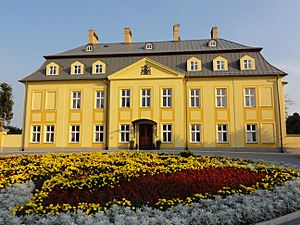Czechowice-Dziedzice facts for kids
Quick facts for kids
Czechowice-Dziedzice
|
|||||
|---|---|---|---|---|---|

John Paul II Square
|
|||||
|
|||||
| Country | |||||
| Voivodeship | Silesian | ||||
| County | Bielsko | ||||
| Gmina | Czechowice-Dziedzice | ||||
| Area | |||||
| • Total | 32.98 km2 (12.73 sq mi) | ||||
| Population
(31 December 2021)
|
|||||
| • Total | 35,684 | ||||
| • Density | 1,081.99/km2 (2,802.3/sq mi) | ||||
| Time zone | UTC+1 (CET) | ||||
| • Summer (DST) | UTC+2 (CEST) | ||||
| Postal code |
43-500, 43-502, 43-503
|
||||
| Area code(s) | +48 32 | ||||
| Car plates | SBI | ||||
| National roads | |||||
| Website | http://www.czechowice-dziedzice.pl | ||||
Czechowice-Dziedzice is a town in southern Poland. It is located in the Silesian Voivodeship, within Bielsko County. As of December 2021, about 35,684 people live here.
The town is on the edge of a historical area called Cieszyn Silesia. It's a very important place for trains, with four stations. Two main train lines cross here: one goes east-west, and the other goes north-south.
Contents
History of Czechowice-Dziedzice
The area where Czechowice-Dziedzice is located was likely part of Poland a long time ago. The village of Czechowice was first mentioned in a document from around 1305. This document talked about two settlements: Chotowitz theutonico and Chotowitz polonico.
Chotowitz theutonico was probably set up using German laws. Chotowitz polonico was an older village that followed traditional Polish laws. This shows it was already a well-developed community.
At that time, the area belonged to the Duchy of Cieszyn. This duchy was part of the Kingdom of Poland. Later, in 1327, it became part of the Kingdom of Bohemia, but Polish rulers still governed it until 1653. The name Czechowice was first used in 1430. The village of Dziedzice was first mentioned in 1465.
Czechowice became a center for a Catholic church. In 1447, it was listed as one of the 50 parishes in the Teschen area. Even during the Protestant Reformation, the Czechowice parish remained Catholic.
Growth in the 19th and 20th Centuries
After big changes in Austria in 1848, new local governments were created. Czechowice and Dziedzice became separate towns. In 1855, a new railway line opened with a station in Dziedzice. This led to fast growth and new factories in both Czechowice and Dziedzice, especially in the late 1800s.
During this time, Czechowice and Dziedzice became important centers for Polish people. Many Polish schools, sports clubs, and other groups were started here. This was different from the nearby town of Bielsko, which was mostly German.
Between 1880 and 1910, the population of Czechowice grew a lot, from about 2,800 to over 7,000 people. Most people spoke Polish. Dziedzice also grew, from about 1,000 to over 2,400 people, with most also speaking Polish. Most people in both towns were Roman Catholic.
After World War I, Poland became independent again. In 1920, the region was divided, and Czechowice and Dziedzice became part of Poland. Factories continued to open, making things like machines, bicycles, and paper. New cultural places, theaters, and sports clubs were also created. In 1924, the Freedom Monument was built using money donated by people. This monument is a place for patriotic celebrations.
World War II and Beyond
In September 1939, at the start of World War II, Nazi Germany took over Czechowice and Dziedzice. People living there faced many difficulties. Some were forced to work in Germany or sent to concentration camps. Polish schools and social groups were destroyed.
In 1942, the Germans set up two forced labor camps in the town. One was for Polish people, and another was for Jewish men. In 1944, the oil refinery in Czechowice was bombed. Also in 1944, the Germans created two subcamps of the Auschwitz concentration camp in Czechowice-Dziedzice. Over 600 prisoners were forced to work at an oil plant there. In 1945, the German occupation ended, and Czechowice and Dziedzice became part of Poland again.
In 1951, Dziedzice and Czechowice officially joined together. The new town was first called Czechowice. But the people of Dziedzice were not happy about this. So, in 1958, the town was renamed Czechowice-Dziedzice.
From 1975 to 1998, the town was part of the Katowice Voivodeship. Since 1999, it has been part of the Silesian Voivodeship. In 1993, a new Freedom Monument was built in the same place as the old one, which the Germans had destroyed in 1939.
Landmarks
Some important buildings in Czechowice-Dziedzice include the beautiful Rococo style Kotuliński Palace. There is also the old Baroque Saint Catherine Church and the Gothic Revival Saint Mary of Help church.
Sports
The local football team is called MRKS Czechowice-Dziedzice. They play in the lower football leagues.
Twin towns – sister cities
To learn about the towns that Czechowice-Dziedzice is twinned with, see twin towns of Gmina Czechowice-Dziedzice.
Notable people
- Piotr Beczała (born 1966), a famous opera singer
- Łukasz Piszczek (born 1985), a professional football player
Images for kids














